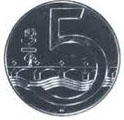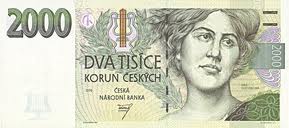|


The Czech koruna or Czech crown (sign: Kč; code: CZK) has been the currency of the Czech Republic since 8 February 1993 when, together with its Slovak counterpart, it replaced the Czechoslovak koruna at par.
The official name in Czech is koruna česká (the genitive plural form korun českých is used on banknotes). The ISO 4217 code is CZK and the local acronym is Kč, which is placed after the numeric value (e.g., "50 Kč"). One koruna equals 100 haléřů (abbreviated as "h", singular: haléř, nominative plural: haléře, genitive plural: haléřů - used with numbers higher or equal to 5 - e.g. 3 haléře, 8 haléřů).
The Czech Republic planned to adopt the euro in 2012, but its government suspended that plan in 2007. Although the country is economically well positioned to adopt the euro, there is considerable opposition to the move within the Czech Republic.
History
The Czech koruna replaced the Czechoslovak koruna when it was introduced in 1993 after the dissolution of Czechoslovakia. It first consisted of overstamped 20, 50, 100, 500, and 1000 Czechoslovak korun banknotes, but a new series was properly introduced in 1993.
The currency was on a record exchange rate run in 2008.
Coins
In 1993, coins were introduced in denominations of 10, 20 and 50 haléřů, 1, 2, 5, 10, 20 and 50 korun. The haléře (hallers) denominations were struck in aluminium, the 1, 2 and 5 korun in nickel-plated steel, the 10 korun in copper-plated steel, the 20 korun in brass-plated steel and the 50 korun with a brass-plated steel centre and a copper-plated steel ring. The 10 and 20 haléřů coins were taken out of circulation by 31 October 2003, and the 50 haléřů coins were withdrawn from circulation on 31 August 2008 due to their diminishing purchasing power and circulation. Coins are currently in circulation are the 1, 2, 5, 10, 20 and 50 korun. The coins all feature the Czech lion on the obverse, with the reverse featuring the value.
Since 1997, sets for collectors are also issued yearly with proof quality coins. In 2000, the 10 and 20 korun coins were minted with different obverses to commemorate the Millennium. In the beginning coins were minted in Hamburg then in the Czech Republic. There's also a tradition of issuing commemorative coins - including silver and gold coins - for numismatic purposes.
Banknotes
The first Czech banknotes issued in 1993 consisted of Czechoslovak notes with adhesive stamps affixed to them. Only the 100, 500 and 1000 korun denominations were overstamped, the lower denominations circulated unchanged during this transitional period. The former circulated until end-August, the latter until end-July.
A newly designed series of banknotes of denominations 20, 50, 100, 200, 500, 1000, 2000 and 5000 korun were introduced later in 1993 and in 1994 and were still in use as of 2006 - except for the first versions of 1000 and 5000 korun notes, since the security features of these notes were upgraded in the subsequent issues (However, the 2000 note is still valid in both versions, with and without the new security features). These banknotes feature renowned Czech persons on the obverse and abstract compositions on the reverse. Modern protective elements can be found on all banknotes.
The 20 korun note ceased to be valid on 31 August 2008.
The text on this page has been made available under the Creative Commons Attribution-ShareAlike License and Creative Commons Licenses
|
